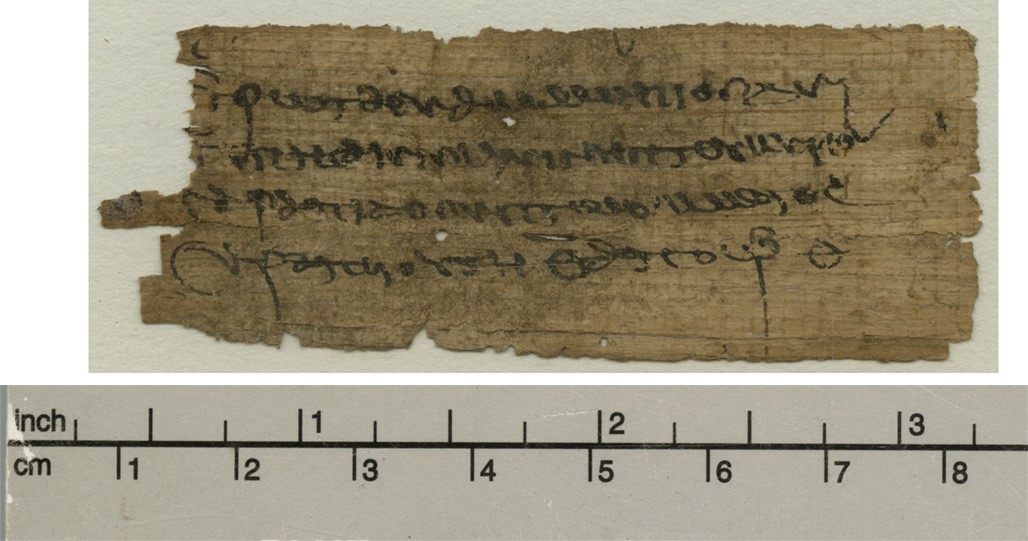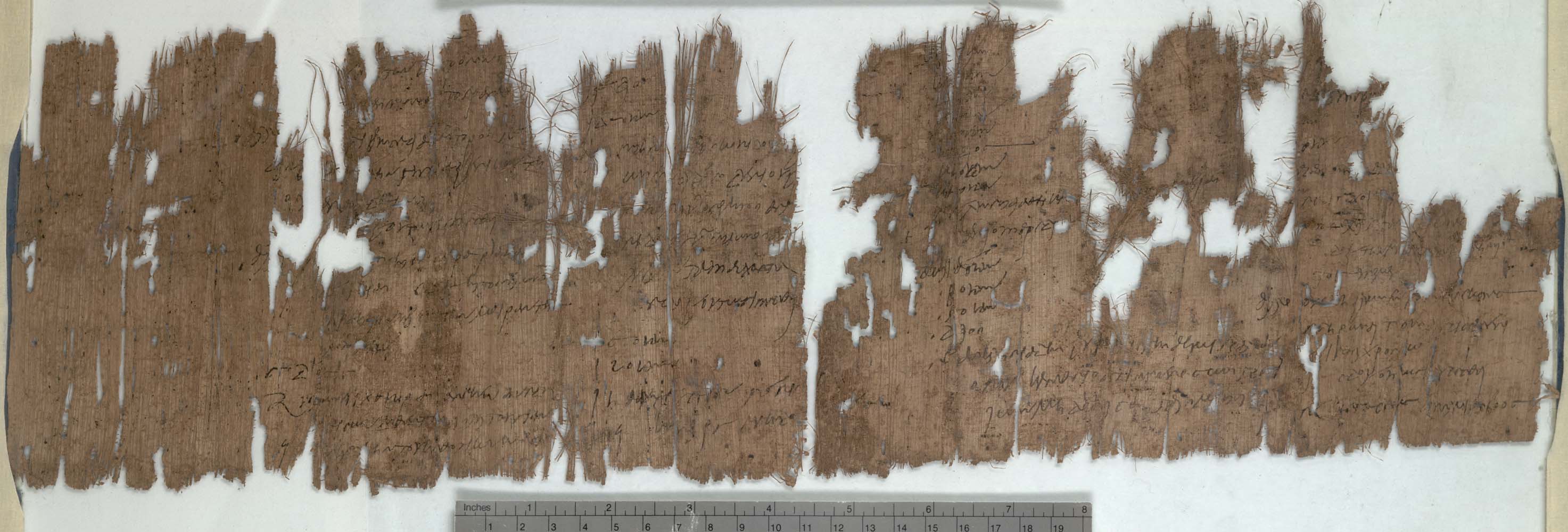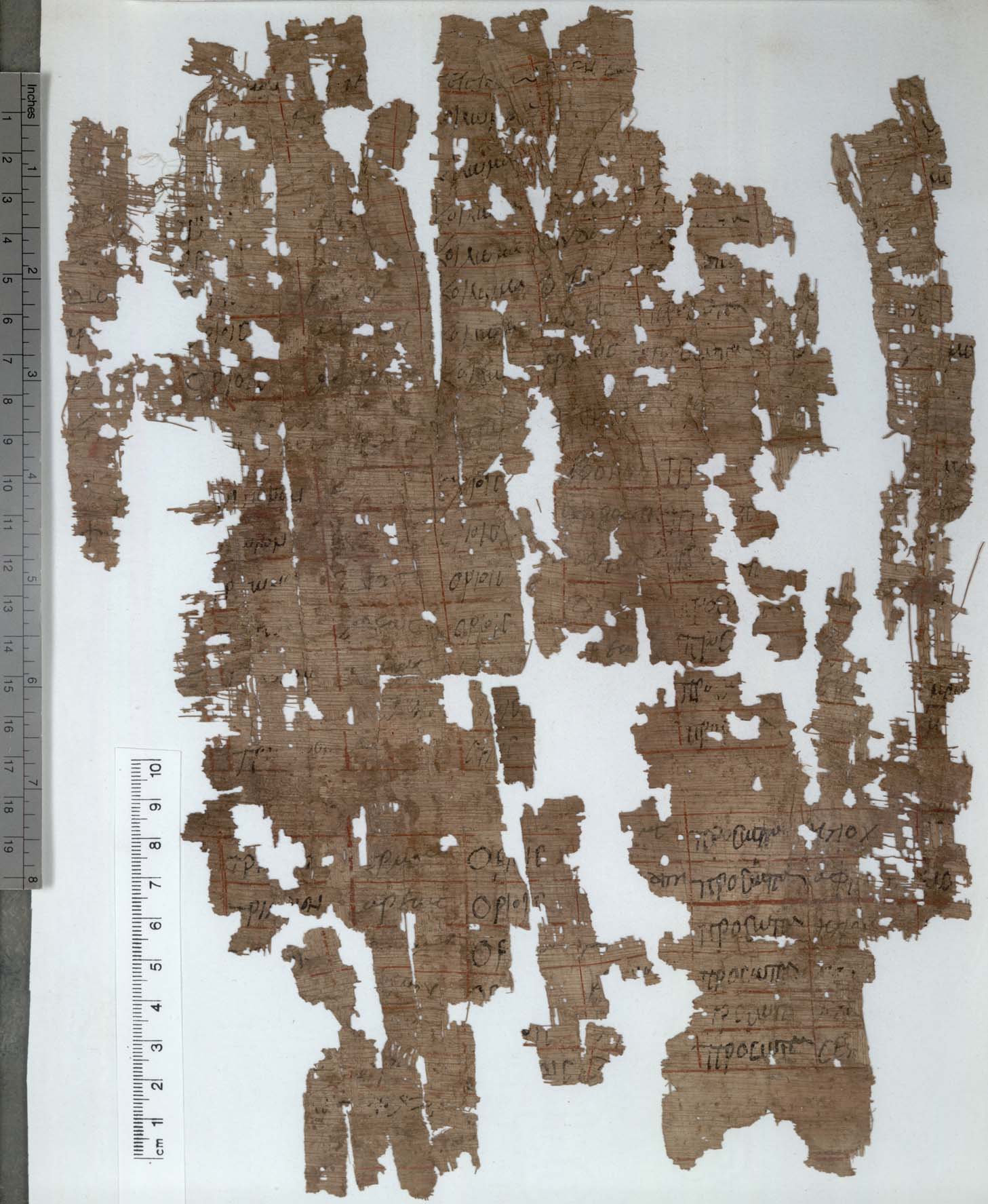Daily Life
Numerous little invitations like this one have survived from the rubbish dumps of Oxyrhynchus. The functions concerned are never very far ahead, often on the same day or the next day. In this one, Ammonius invites the recipient (who is unnamed) to a banquet in connection with the cult of Sarapis, in the dining-room of the Serapeum, on the 9th day of an unspecified month (so a month ahead at most), starting at ‘the 9th hour’.
In the absence of Auntie Marge’s Problem Page, a person could apply to a temple oracle in the hope of a solution to a personal problem. The usual practice, inherited from Egyptian religion, was to submit a pair of slips like this to the priest, each asking a question, of which the second question would effectively be the negative of the first; one of the two slips would be returned to the petitioner. This example is unique in apparently having the answer nai, ‘yes’, at the foot.
These certificates were issued to those who satisfied the pagan commissioners during the persecution of Christians under the emperor Decius. Forty-six such certificates have been published, all dating from this same year, four of them from Oxyrhynchus of which this is the most recent example to be published.
This item records the daily activities of an unidentified official over a period of more than a month. Apart from the frequency with which the level of activity was ouden, ‘nothing’, most interest attaches to the entry every seven days of the word Dios = dies Iovis = Thursday, when the official also did nothing. Contrast the tall report of legal proceedings, from just over a decade later, by which time officials took Sundays off; at so early a date, though, that might indicate no more than a readiness to conform to new patterns, not a change of personal beliefs.
This was a novelty when it was published in 1957, and nothing comparable has been discovered since. The plan shows three main areas, possibly courtyards rather than rooms. The central one is described as an atrium, and from it a staircase descends to a cellar which was probably vaulted. At 90°, a row of parallel lines would represent a staircase on a modern plan, but that may not be the right interpretation here. A boxed rectangle adjacent might be a water-tank, or a central staircase-well with the parallel lines marking a stair to an upper floor; the stair down to the cellar, already mentioned, would then turn a right-angle and continue down underneath the upper flight.
An order from the head of the council of Oxyrhynchus to the police officers in a country village to arrest a man described as a Christian (lines 4–5). No reason for the arrest is given; we cannot assume that we are looking at evidence for persecution, although this is possible. A period of Christian persecution was instituted under the emperor Valerian in AD 257 and 258.
This is one of the earliest uses of the word ‘Christian’ on a papyrus. Seventy years later, it would no longer have been dangerous to admit to being a Christian.
This large piece was once probably sixteen columns wide, twice as wide as it is now. The columns recorded the zodiacal positions of the Sun, Moon and five planets (Saturn, Jupiter, Mars, Venus, Mercury), and various astrological concepts. These data were those applicable at the time of birth of a person whose name is now lost; the moment has been computed as 4 a.m. on 7 July, AD 430.
This is an almost unique survival from antiquity; only one other fragment, also from Oxyrhynchus but largely illegible, is comparable (The Oxyrhynchus Papyri vol. LXI no. 4286).
Private letters in the Roman period typically have the letter’s text on one side of the papyrus only; the back is kept for the address, typically a single line down the back at right-angles to the text on the front. This was because the practice was to fold the letter into a thin ‘spill’, which would be tied around with a fibre of papyrus and sealed with a small clay seal; the address — typically simply in the form ‘To X from Y’ — would be written down one of the sides left exposed (generally the side with the seal), which are usually much dirtier than the protected inside surfaces. Only rarely are house details given as part of the address. Except for those on government and military service, there was no organised postal service; letter-writers normally would have to rely on delivery by a carrier who knew where to find the addressee. A letter might never reach its destination.
A Private Letter, circa AD 217/18
The back of this letter is exhibited for its unusually elaborate address, written in two panels which perhaps occupied both sides of the ‘spill’ into which the letter had been folded for delivery.
When the letter had been folded, it was tied and then sealed with a clay seal through which the tie would run. For added security, ink marks were then made running across the top of the seal; this is why the names of sender and addressee on letter backs are frequently separated by a large X with its centre missing, that being the point where the seal had been affixed. The ink marks here are clumsy but there seems to be a blank patch as expected. The upper ‘ladder’ may be the remains of lines that were drawn across the tie on the other side of the spill.
The address translates: ‘From Sarapas and Gaia’, and then in the lower panel ‘To Eutyches who distributes wreaths under the gateway of the Serapeum by the great image.’ Added almost as a postscript at upper right: ‘Give (the letter) to Ammonius who distributes wreaths at the shrine of the god, and he will give it to him.’
A tantalising fragment of a letter (or quotation of one) which alludes to the activities of a ‘one-eyed’ astrologer, as though part of a plot of a novel. The hand, however, which is informal and documentary, is not the sort expected for a literary text. The author refers to the arrival ‘up there’ (ano) of one ‘Serenilla’, which sounds like an event of everyday life, and to a festival. Another event is dated by the narrator by the rise of the Dog-star, which presaged the rise of the Nile flood and was therefore important in the Egyptian calendar and religion.
‘... I withdrew and went to sleep, and I sent the astrologer — the one-eyed one (monophthalmon) — to call you and he said that he could not find you. At lamp-lighting I returned and when I heard from Serenilla the things that you had done to her I was upset that you behaved in a way unworthy of you. So receive her kindly up there before the (end of the?) festival. And I would have been there already had I not been ‘dog-devoured’ (kunobrotos, i.e. bitten by a dog?) on the very day of the rise of the Dog star, the 25th, by a mad dog, and until now I ... terribly ...’.
A private letter from one Elis to his friend Carpus, reminding him about some household effects he has ordered. The author then appears to date a planned future occurrence by the arrangement of star-signs, i.e. the kind of data found in astrological texts: ‘when the Moon is in Sagittarius ...’. He goes on to specify variable options in the calendar when such a position would be possible. For this calculation it would have been necessary for him to consult an astronomical calendar or ephemeris, of which examples survive on papyrus. Perhaps Elis is an astrologer providing or relaying the information of a katarchic horoscope (i.e. one which provided the basis for individual decision-making) to his associate, advising him of the best day for his planned meeting. The arrangement of star-signs and the days specified allow us to date the planned meeting precisely: within the first four centuries AD, only the year 194 gives a position implied by the letter.
‘Elis to his most esteemed Carpus, very many greetings. Don’t forget about the order for the three plates, two big ones and (one line missing here, perhaps ‘and one small one’). ... meet (or: make a contract with) your friend when the Moon is in Sagittarius, at the 4th hour; it arrives there on 12th Thoth; it is there again also on the 13th and 14th until the 7th hour. At these times meet (or: make a contract with) your friend. Farewell.’
This document, and the attestation of sale of some other landed property that is drawn up to its right on the same sheet (dated August 139), exemplify the format of routine private property contracts in the second century, although they are not often preserved on this scale.
Re-used on the back for an account of fishing revenues (The Oxyrhynchus Papyri vol. XLIX no. 3495).
In Roman Oxyrhynchus, literature, painting, and the plastic arts go hand in hand. This papyrus contains popular verses executed carefully in a good cursive, interspersed with coloured line-drawings illustrating the lively content: Labours of Heracles.
Narrated and illustrated is the killing of the Nemean Lion, the first labour (protos athlos), source of Heracles’ trademark skin. So the fragment probably comes from the beginning of the roll.
In the second of the three scenes Heracles is depicted as naked, strangling the tawny lion by pressing its head under his armpit. His club is coloured yellow, but it seems to lean against something invisible; the identity of the object over the club is a puzzle. The lion stands on higher, green-coloured ground. The other two scenes are equally mysterious: the third very probably shows Heracles holding the lion skin (coloured green) in his ‘strong arms’, with legs and tail dangling.
Greek popular literature in Oxyrhynchus often drew on Classical models. This papyrus contains Homeric verses (most taken from Iliad 23.65ff) illustrated in the upper register by an armed figure.
The verses concern Achilles’ meeting with the ghost of Patroclus. Achilles tries to set out; each time the ghost turns him back, uttering a prophecy of Achilles’ own death. If the figure goes with the lines that follow, it ought to be Achilles. He leans forward, right arm extended, wearing a bowler-shaped hat or helmet; cross-hatching on the legs indicates boots or greaves. A red patch on the shoulders stands for a fluttering cloak. The left hand wields a spear and small red shield.
Two fragments bearing a text identified as Archilochus’ fable of the fox and the eagle. The text has been annotated in the margin in a later, cursive hand. There are later versions of the fable by Aesop, Phaedrus and Babrius. A fable of the last also survives on another Oxyrhynchus papyrus, as well as an anonymous Latin fable about the dog who saw his own reflection while crossing a stream.
This handsome manuscript, the second of its three columns complete, is the only known papyrus of Esther in roll-form, and the only papyrus manuscript to have this passage. A roll (as opposed to a codex) is a rare format for Biblical texts, and may point to a Jewish provenance.
Thirteen papyri with musical notation from the Oxyrhynchus collection have been published, seven of them (of which this is one) in volume LXV.
Presumably these pieces were written by and for professional singers and musicians. They probably represent recital items; it is known from other sources that musicians in the Roman period regularly performed selections from Euripides and other poets, set to music of their own.
The musical notation takes the form of letters of the alphabet and other supplementary symbols written above the syllables of the poetic text, each one signifying a particular note. Groups of two or three notes that belong to the same syllable are linked together by a tie-line below and/or a double point (:) following. Longer time-values may be indicated by lines above the notes, but in general the rhythm is given by the metre of the verse. The interpretation of the note-symbols is known from a treatise on music by Alypius (fourth century AD?).
This appears to be a draft for a programme of chariot racing and other displays. It has been countermarked by a second person; perhaps it passed between two municipal officers for approval.
‘For good fortune. Victories(?). 1st chariot race. Procession. Singing rope-dancers. 2nd chariot race. The singing rope-dancers. 3rd chariot race. Gazelle and hounds. 4th chariot race. Mimes. 5th chariot race. Troupe of athletes. 6th chariot race.’ (2nd hand) ‘Farewell.’
The Oxyrhynchus Papyri vol. XXXIV no. 2707.
Ostraca, broken pottery fragments, provided a cheap and readily-available surface for writing brief short-term messages, and have been found in their hundreds in remote desert sites where papyrus was not so easily to be had.
This is one of an archive of over 100 similar texts, all orders to supply wine to various personnel involved in chariot racing in the hippodrome of Oxyrhynchus. A large jar a day for six days is the ration authorised here.
The ‘Blues’ and the ‘Greens’ were notorious chariot-racing factions. That this was as true in Oxyrhynchus as elsewhere is shown by the inscription in favour of the Blues that had been roughly carved at the top of the ‘Phocas pillar’.
John Shelton, Greek Ostraca in the Ashmolean Museum (1988), no. 83.
No cinema, no TV. The monotony of rural daily life could be broken by performances by travelling groups of musicians and the like, such as the group here hired to perform for seven days in a small village in the Oxyrhynchite district.
The practice of magic, generally erotic or aggressive in purpose, must have been a major preoccupation for many people. This extensive text — it continues on the back — contains an extraordinary and complex blend of Greek and Egyptian religious and mythological elements.
A magical spell with a drawing of a magical figure, probably representing the Egyptian god Seth. He is depicted as an ass-headed human, equipped with a whip and a spear or a torch.
The spread of Christianity did not bring an end to magical practices; the new religion was absorbed into the magical repertoire as the older religions had been. This little item is a perfect example; the text, which would have been rolled up and carried as a good luck charm, carries a copy of the apocryphal letter of Abgar of Edessa to Jesus Christ (line 2) in Jerusalem. The text of the letter is interrupted by a prayer in semi-Coptic to heal Epimachus, obviously the amulet’s owner, and further adapted at the end with magical signs and a quotation from the Psalms.
Particularly urgent or casual writing also could be executed on broken pottery (ostraca), or even on whole vessels. This earthenware bowl in the Institut für Altertumskunde, Cologne, is inscribed horizontally around its circumference with a magical love-charm to attract the favours of one Matrona daughter of Tagene to the smitten Theodorus son of Techosis, who commissioned the charm. The bowl came from a cemetery at Oxyrhynchus where it had been entrusted for communication to the powers of the underworld. The letter-shapes are familiar from contemporary documentary texts. The writing follows the horizontal ridges formed by the throwing of the pot as though guide-lines for writing.
The text of the love charm on the bowl is identical with that inscribed on two defixiones, inscribed love-curses on lead tablets.
All three were found together with another terracotta bowl, uninscribed but stuffed with an extended love-charm written on papyrus, which was further wrapped around two humanoid figures formed out of wax, holding each other in a sympathetic embrace.























